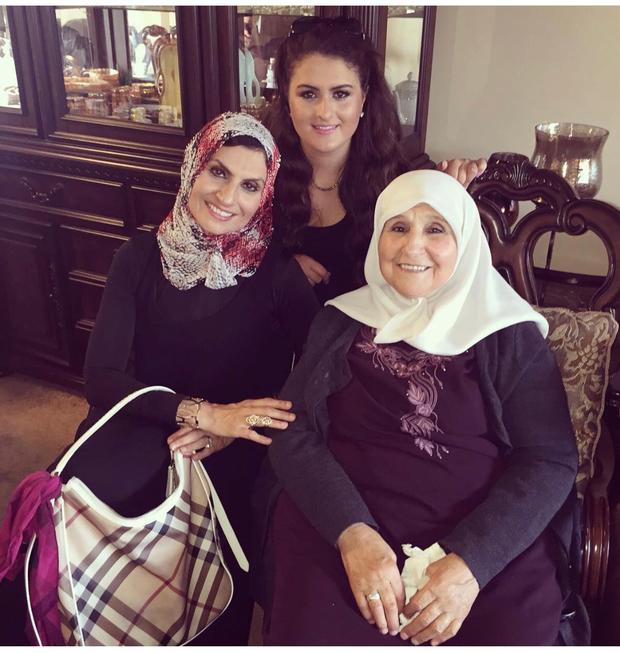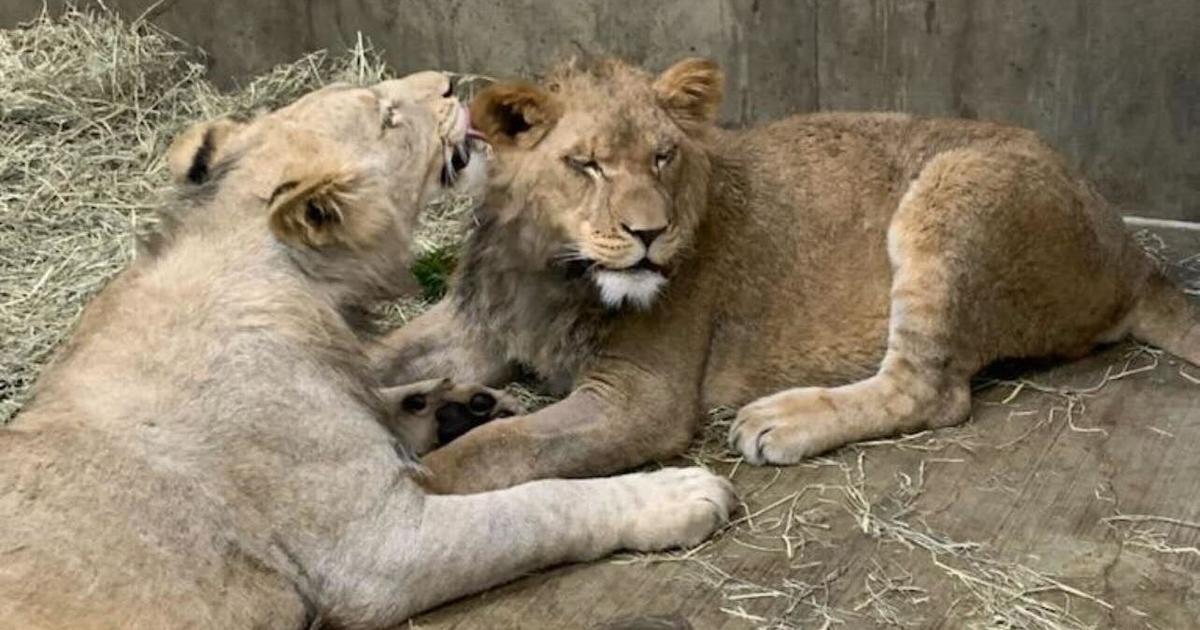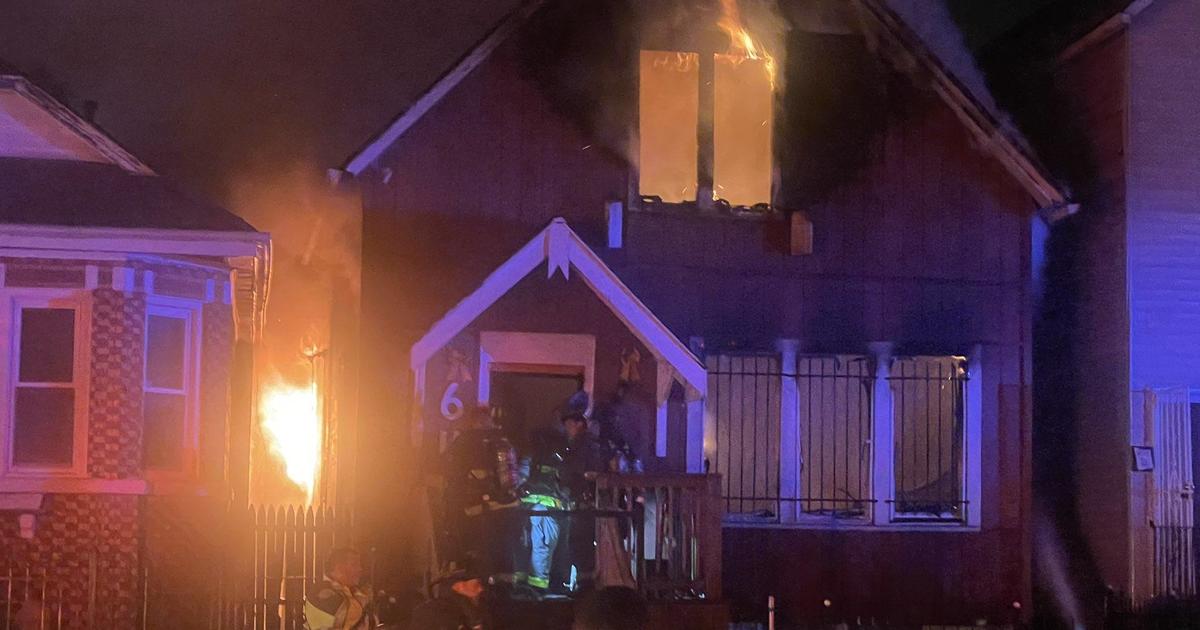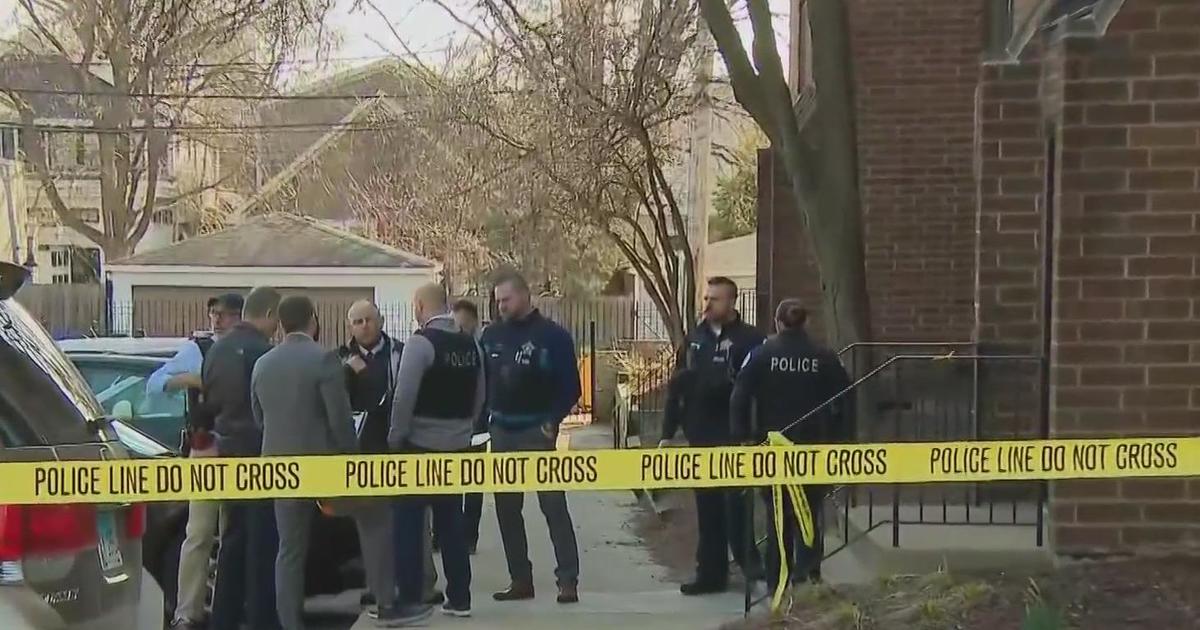Across Illinois, Arab Americans Were Dying From COVID-19, But The Government Wasn't Counting. Some Say That Cost Lives
By Samah Assad, Dorothy Tucker, Chris Hacker
CHICAGO (CBS) — The memories Arwa Abulaila has of her mother, Ayseh, remain in her head and in the palms of her hands.
In her mother's Palos Hills' home – the place where her family took care of her – Arwa clutches her iPhone as she watches old family videos.
The first one is of Ayseh sitting on a chair, her hands raised and enveloped by her granddaughter's, both swaying to an upbeat Arabic song.
"It's her granddaughter, right before her wedding," Arwa remembered, smiling. "We did a party at the house, and she came to her to dance with her because she can't get up to dance."
Next, Arwa plays another video of her mother speaking to the camera. This one makes Arwa break down.
"I wish she was here," Arwa said in tears. "I wish she didn't leave us. We miss her."
Arwa said her mother, an Arab American immigrant from Palestine, was well respected in the community. A regular at the Bridgeview Mosque Foundation and a devout Muslim, Ayseh accomplished and was recognized for a big feat: memorizing 80 percent of the Qur'an.
"Everyone in the mosque, when they heard the news, the sheikh contact my brother-in-law. They said, wow, we really lost a good person today," Arwa said. "She loved to donate, she loved to [give] to charity…if she heard somebody needed help, she would run and help them."
What started as a cough led to a trip to the hospital in June of 2020, at a time where family members couldn't visit loved ones to contain the spread of the virus.
Arwa said Ayseh knew limited English and struggled without her family there.
"I used to call her, and she was screaming," Arwa said. "'Please come pick me up, take me home. I don't want to stay there. I'm thirsty, they don't understand what I want. I can't tell them what I need.'
"And the last words she told me: 'Come get me. If you love me, come get me.'"
The next day Arwa received devastating news.
"They took her to the ICU and she was in a coma until she passed away," Arwa said. "Her situation got worse every day, every day. And we couldn't say bye to her."
According to health experts interviewed by CBS 2, many factors point to Arab Americans being a high-risk group for contracting COVID-19. Anecdotally, community organizations say, funeral after funeral, they watched the deaths devastate communities firsthand at the height of the pandemic.
But because local and federal governments don't track data on Arabs specifically, no one knows how many contracted the virus or died. Advocates say lives could've been saved early on if they had hard data.
'The Invisible Community'
The Cook County Medical Examiner's Office maintains public data documenting COVID-19 deaths and their locations. CBS 2 has used that data to determine the hardest hit communities in Chicago were those where majority Black people and Latinos lived.
But because there is no category for Arabs, it's impossible to determine how many from that group died or where.
Through interviews with Arab American community organizations, CBS 2 identified a list of eight Chicago suburbs with notable Arab populations.
At the start of the pandemic, several of those towns were among the hardest-hit by the first wave of COVID-19.
May 2020 was the peak of the first wave. At that time, Bridgeview, Palos Heights and Summit — three suburbs with vibrant Arab American communities — were among the top 10 percent of all cities and towns in Illinois in terms of COVID cases, according to data from Muckrock analyzed by CBS 2.
At that point during the pandemic, Bridgeview, home to a large Arab American population and the Bridgeview Mosque Foundation, had the seventh highest rate of new covid cases of any city in the state.
"We saw very much what so many other communities saw, especially communities of color, communities that are already having difficult times socioeconomically," said Hatem Abudayyeh, Executive Director of the AAAN.
"We heard anecdotally and got a number of phone calls from people who were dealing with the illness, Abudayyeh said. "People were affected by the virus and getting sick at the same levels, maybe higher levels, than others."
But it's nearly impossible to know exactly how many fell sick or died, because their race or ethnicity weren't documented in a way that would indicate they were Arab.
That's what happened to Arwa's mother, Ayseh. Until CBS 2 told her, Arwa had no idea her mother was listed as "Other" by the Medical Examiner. She said Ayseh would've identified as Arab.
"I feel like we're not noticed, I feel like we're left behind," Arwa said. "I feel like we're left out, we're not noticed in America. We are a big community right now, big number of Arabs, Muslims here.
"And I think they should consider us like we are part of America here, and they need to add [Arabs] to the category."
Abdelkarim Haj experienced something similar, according to his nephew, Husam Farraj.
Farraj said his late uncle was "very proud of his [Palestinian] identity."
But CBS 2 found Haj, who died from COVID in December of 2020, was designated as "Asian" by the Cook County Medical Examiner's Office.
"He didn't consider himself that at all, nor did I, nor did the people around him," Farraj said. "Nor did the doctors that he dealt with, nor did the mechanics, the bankers, nor did anybody in the community. So why is the data saying that?"
With no comprehensive data, community organizations told CBS 2 they struggled to get timely funding that could've helped the Arab community early on.
"This is part of our continuous struggle for the past 20 years that we've started this organization," said Itedal Shalabi, co-founder of Arab American Family Services (AAFS). "We continuously have to chase the funding, we continuously have to knock on people's doors, we continuously have to say, 'Here's a community that's in dire need.'"
All they have left, Shalabi said, is anecdotal information. But funders often want hard data.
"[Funders] would always ask us that question: 'How do you know?' And we know. It's here. It's in our community," Shalabi said. "But we can't give you statistics, we can't give you evidence-based research, because, again, as Arab Americans, we're labeled as white."
Shalabi said AAFS did receive about $300,000 from the Cook County Department of Health to be used for COVID testing and education, but not until October of 2020 — eight months after the pandemic began.
More troubling, the money didn't kick in until December, by which time more than 12,000 Illinoisans had already died of COVID-19, and the first vaccines were being administered to healthcare workers.
"The reality is of not having this information and being able to identify the number of people that died in your community because of covid, it's heartbreaking," Shalabi said.
Before the money came through, AAFS estimated they spent over $100,000 in staff time on their own with efforts on their own educate the community as the pandemic was taking hold. The group serves 15,000 families a year through social services including food assistance, mental health and domestic violence support, among other services.
Much of the work of the COVID-19 response fell to community organizations like AAFS and AAAN, including translating critical health information during a rapidly evolving pandemic and holding virtual panels with medical experts.
AAFS said they also struggled to get funding for vaccine education, and only recently received $25,000 for vaccine awareness.
"Without that funding, without that resource, having it so late, what was the impact of the months that you did not have that money?" asked Nareman Taha, co-founder of AAFS.
"That resource, that information, was so important to have early on to show that our community members, 'Hey, this could be you,'" Taha said. "The reality is it took months, months of working as an organization, to bring back that education and resources to the community, to make sure that they understand that COVID does not know communities, does not know race or faith."
The work to fight COVID in the community continues. In early April of 2021, AAFS staff canvassed neighborhoods to spread the word about testing and vaccines. They also held food drives as incentives for people to get tested.
The same happened at AAAN during the pandemic, which helped Arab Americans navigate the unemployment system. They also partnered with the Immigrant Rights Coalition and Illinois Department of Human Services to distribute $100,000 to undocumented immigrants in the community affected by the pandemic.
To try to fill the void of public health information, Abudayyeh said AAAN also created WhatsApp groups to communicate the latest guidance in Arabic. He estimated the group reached around 10,000 people with its efforts during the pandemic.
Taha said the lack of information from government officials early in the pandemic gave many in the community a false sense of security.
"Not having it in their communities, not seeing it visible in their markets, in their schools, they thought they were untouchable," Taha said. "They thought they were invisible. They thought, 'This doesn't impact us,' not realizing that their neighbor was being impacted."
On a deeper level, Shalabi said, "Our community as an Arab American community being counted as white, we are the invisible community."
"It's frustrating," Shalabi said. "Am I that not important to you to care about me as a community? That I don't have a box?"
At Risk, But No Numbers
Currently, there isn't an option for those who identify as Arab to select a category in Census forms. Data from the the census is a critical tool used to collect population and demographic data. It's integral in deciding how federal funding will be doled out to communities across the country.
Illinois is home to more than 143,000 Arab Americans, the fifth most in the country, according to an estimate by the Arab American Institute, a national organization that advocates for the needs of the Arab American community. Still, CBS 2 found local government agencies haven't been recording them as such when collecting COVID-19 testing and vaccination data.
Oftentimes Arabs must choose between "White," "Asian" or "Other."
But health experts said there are stark differences in the chronic health and lived experiences of Arab and white Americans. This includes key factors that could put Arabs at higher risk of contracting the virus, similar to other minority groups.
"What this means is that Arab Americans are continuing to go through the pandemic, perhaps at an increased risk," said Dr. Nadia Abuelezam, an epidemiologist and professor at Boston College.
Abuelezam, who studies health inequities, including those that impact Arab Americans, pointed to her research that shows a higher rate of diabetes, heart disease and obesity are more prevalent in Arab populations than they are in White populations. Those underlying conditions are also risk factors for severe COVID-19.
At the height of the pandemic in June of 2020, Abuelezam published an article in the US National Library of Medicine - National Institutes of Health, making a case for why COVID data on Arab Americans should be isolated.
Experts argue being counted is just as important now as vaccinations continue to roll out across the state, and equity is top of mind.
"If you don't have the data, you don't have the resources," Abuelezam said. "We aren't able to target communities that might be in need, and we're not catering to every community as we should be as public health professionals."
Socioeconomic factors increase that risk too. Arabs are more likely to live in multigenerational, larger households, work in essential roles and experience discrimination. But the lack of comprehensive data challenges researchers who work to combat inequities experienced by Arabs. It's difficult to do, they say, if people aren't being counted.
"It's upsetting. I've dedicated my career to better understanding the needs of Arab Americans, and there's hurdle after hurdle," Abuelezam said.
"I think what's particularly distressing is we knew there are many Arab communities that are quite vulnerable, that are experiencing quite a bit of discrimination and stigma," she added. "I particularly worry about the lifelong consequences of these disparities."
While they're often designated "white" in data, Arab Americans don't benefit from the privileges of being white, according to Louise Cainkar, a professor of sociology at Marquette University and board member of the Arab American Action Network (AAAN).
"We've known now for decades that Arab Americans do not share the privileges of whiteness," Cainkar said. "They face extensive prejudice and discrimination. They are victimized by hate crimes based on their identities."
Despite the discrimination they face, Cainkar said, "they can't make claims about it without the data" in all aspects of their lives, whether it's an educational setting, reporting a crime to police or documenting important health information, like in the case of COVID-19.
A Historical Fight to be Counted
It's long been known that Arab Americans are left out of many critical data collection programs, including the Census. Advocates aren't surprised that historical lack of representation would, in turn, impact the community during a pandemic.
Time and again since the 1990s, advocates have pushed for a category to fit this diverse group. But in both the 2000 and 2010 censuses, the efforts fell short, said Cainkar, who has been working on the issue for more than 30 years.
Cainkar said many in the community thought the 2020 Census would be the first to finally include Arab Americans — this time under the category of Middle Eastern and North African (MENA).
"The Census Bureau did extensive testing, and we were really down to the point of … 'we accept the category MENA — Middle Eastern, North African — does it go under the race white, does it go under a separate category like Hispanic?' Like we were down to that level of placement," Cainkar said.
But before the changes could be finished, Cainkar said, the Trump Administration's Office of Budget and Management abruptly cancelled any further work on the category.
At a 2018 quarterly meeting, the Census said it would not add a MENA category in 2020 because they needed to do more research. This came, they said, after they received feedback showing a large segment of that population who believed MENA should be treated as a formal ethnicity.
"We've only tested MENA as a separate category in the question on race," said Karen Battle, chief of population division with the Census, at the meeting. "So what we need to do is to do more research and testing, where we're testing MENA as an ethnicity, separately from the race question. And that's what we have not done."
A link to a "frequently asked questions" page is what a Census Bureau spokesperson Leslie Malone sent in response to CBS 2's request for information on the status of adding a MENA category. The page didn't address any of the specific questions CBS 2 asked.
The next chance advocates will have to make the change won't happen for another 10 years, in the 2030 census.
But Cainkar said advocates don't plan to wait. They are shifting their efforts to local governments. Their goal is a bottom-up approach that starts with getting the MENA category on state forms and university applications.
Getting better data to community organizations can help them make better decisions when trying to meet the needs of those they serve, Cainkar said.
"If we want to direct services to a population, we have to know their needs, we have to know what they're facing," Cainkar said. "If we want to build community organizations that can address those needs, we have to know what they are."
A Solution in the Works
That work is already happening in Michigan, where state officials have been collecting COVID-19 data on Arab Americans. A state dashboard shows just under three percent of all cases in the state were in those who identified as Arab.
It's still difficult to tell the rate of COVID-19 cases in the Arab population — a statistic that can easily be calculated for Hispanic or Latino residents, on whom the Census collects data regularly. But it's a start, said Mona Makki, Director of Community Health and Research at the Arab Community Center for Economic and Social Services (ACCESS) in Dearborn, Mich., which has one of the largest Arab populations in the country.
"When we're looking at race and equity, making sure that we're looking at all groups of folks and how they have been impacted by the pandemic and by this virus, it becomes incredibly important for us to be able to share data for education purposes, for prevention purposes, and really letting folks know why it's important," Makki said.
Makki said she hopes this change will improve health data for Arab communities going forward.
"This has been an ongoing issue when it comes to cancer, when it comes to substance use disorder, when it comes to mental health," Makki said. "This pandemic really has shed light on how incredibly important it is, in the midst of a pandemic, to be able to provide information and be able to develop and tailor resources to a specific community such as the Arab American community."
A similar change is in the works in Illinois — though that process didn't start until well into Illinois' vaccination campaign. When CBS 2 asked the state why Arab Americans weren't being tracked in COVID-19 data, spokesperson Jordan Abudayyeh said officials are in the process of adding a MENA category to the state's vaccination data collection system.
That change won't be fully in effect for several weeks, Abudayyeh said. More than 30 percent of Illinoisans are already fully vaccinated, meaning Arab ethnicity data won't be captured for those 4 million people.
In Cook County, the Medical Examiner's Office and Health Department both told CBS 2 they use criteria defined by the state and federal governments, though it's unclear when and if they will adopt the MENA category once the state implements the change.
A spokesperson for the Chicago Department of Public Health told CBS 2 they would support the addition of a MENA category to statewide systems.
"We believe if the city does it, everyone else will come along," Cainkar said. "If the county does it on its forms, everyone else will come along. "If the state does it on its forms, everyone else will come along."
To advocates, counting Arab Americans does more than improving health data.
"It's really about being able to quantify, being able to count, and in doing so I think you're also recognizing the lived experiences of Arab Americans in a way that they've never been recognized before in this country," Abuelezam said. "I think that has some merit as well."
For families who've lost loved ones, checking a box that says something other than "other" can feel like validation of their experience.
"It would feel good, to be honest," Farraj said. "I'd be like 'Oh, okay, I'm being recognized.' Not being able to be recognized sometimes can make you feel like you're a stranger in a land that you claim like you were born and raised in. And that's not a good feeling."
Arwa, who's still grieving the death of her mother Ayseh, agreed.
"We're not no one -- hear us " she said. " I will be very happy to see them put Arab. It will make a huge difference for us."





